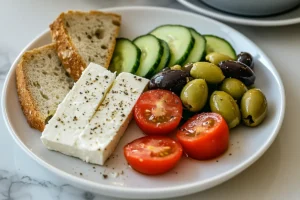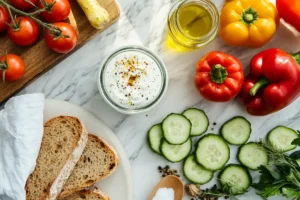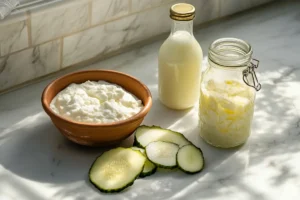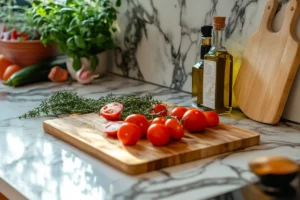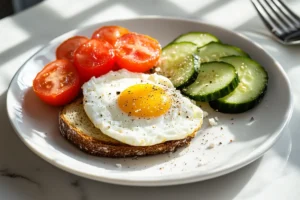Is the Balkan diet healthy? Here’s Why You Should Care
Is the Balkan diet healthy? That’s the question I’ve been hearing a lot lately—and it’s a good one.
Hi, I’m Sylvia, the heart and hands behind DawnRecipes.com. Over the years, I’ve stood in kitchens from Brooklyn to Belgrade, and one thing I’ve learned is this: what we eat tells a story. And the Balkan diet? Oh, it’s a story worth hearing.
So, why the growing interest? The Balkan diet is making waves because it’s simple, flavorful, and deeply rooted in tradition. It brings together rich cultural heritage and nutrient-packed ingredients—all without the need for trendy superfoods or hard-to-find spices.
What makes it special?
- It’s mostly made from real, whole foods.
- It blends Mediterranean influences with local flair.
- It’s not just about what’s on your plate—it’s how you enjoy it.
Is the Balkan diet healthy? Yes, and today I’ll walk you through why it’s getting all this attention—and what you can take from it to nourish your body and soul, no matter where you live.
Let’s dive into five nutrient secrets that make this traditional way of eating something truly powerful.
Is the Balkan diet healthy? Let’s Talk Nutrient Power
So, is the Balkan diet healthy? Let’s break down what makes this way of eating stand out—and how you can bring a little of that goodness into your own kitchen.
A Glimpse at the Core Ingredients
At the heart of the Balkan diet, you’ll find real, down-to-earth ingredients. These aren’t fancy or complicated—they’re everyday foods that nourish deeply.
Here’s what fills most Balkan plates:
- Fresh vegetables like tomatoes, peppers, cucumbers, and leafy greens.
- Fermented dairy like yogurt and kefir, rich in probiotics.
- Whole grains such as rye bread, buckwheat, and barley.
- Legumes—beans, lentils, chickpeas.
- Lean meats and fish, often grilled.
- Olive oil and sunflower oil for cooking and dressing.
These foods are loaded with nutrients that support energy, digestion, and long-term wellness. And the best part? You don’t have to be a gourmet chef to prepare them.
The Balance Behind the Diet
What I really love is the natural balance built into this diet. It’s not about cutting carbs or skipping fat. It’s about variety and moderation.
Here’s how it works:
- Meats are a side dish, not the star.
- Vegetables are always the main event—often eaten raw.
- Dairy is fermented, which helps digestion.
- Meals are shared and slow, not rushed.
Back in my grandmother’s Brooklyn kitchen, she’d always drizzle a little olive oil on a salad and say, “This is the good stuff.” And she was right—those small touches add big flavor and even bigger health benefits.
So yes, if you’re still asking, is the Balkan diet healthy?, the answer keeps leaning toward yes—with ingredients and balance like this, it’s hard to go wrong.
Is the Balkan diet healthy? Science Says Yes – Mostly
Now let’s look at what the science says. Is the Balkan diet healthy? Yes—and here’s the evidence to back it up.
Digestive and Heart Health
One of the biggest health wins of the Balkan diet is its impact on your gut and heart.
Let’s start with digestion:
- Fermented foods like yogurt, kefir, and pickles feed the good bacteria in your gut.
- A healthier gut means better immunity, smoother digestion, and even better mood.
And for your heart?
- The diet is naturally low in saturated fats and rich in fiber.
- It includes antioxidant-rich vegetables and lean proteins, both great for keeping cholesterol in check.
Table: Balkan Diet & Heart Health Boosters
| Food | Benefit |
|---|---|
| Yogurt/Kefir | Gut health, immunity |
| Olive oil | Healthy fats, reduced LDL |
| Peppers, Tomatoes | Antioxidants, reduce inflammation |
| Whole grains | Lower blood sugar, steady energy |
Weight Control and Energy Levels
Because of the fiber and protein combination, this diet keeps you full longer. You’ll snack less and have fewer sugar crashes during the day.
Some practical takeaways:
- Start your day with a vegetable-heavy plate.
- Pair whole-grain bread with eggs or cheese for balanced energy.
- Stick to smaller portions of meat, and let plants take center stage.
I’ve found my own energy stays so much more stable when I eat Balkan-style. No mid-morning crashes, no reaching for a second coffee. Just steady, feel-good fuel from real food.
Compare with Mediterranean Diet
The Balkan diet is often compared to the Mediterranean one—and for good reason:
- Both favor fresh produce, grains, and olive oil.
- But the Balkan version includes more fermented dairy, raw veggies, and traditional cured meats.
- It’s a little more rustic, a little more grounded—but just as powerful.
So again, if you’re wondering, is the Balkan diet healthy?, the research and results speak for themselves.
Is the Balkan diet healthy? What You Need to Watch
(Word Count Target: ~230)
Let’s keep it real for a second. Is the Balkan diet healthy? Yes—but like any diet, there are things to keep an eye on.
Not All Plates Are Equal
Even the healthiest traditions can lose balance if you’re not mindful. Here are a few things I’ve learned in my own kitchen:
- Cured meats like sujuk or smoked pork belly taste amazing, but they’re high in sodium and preservatives. Enjoy them in small portions, not daily staples.
- Heavy bread portions can tip the scale. Try whole grain sourdough instead of fluffy white loaves.
- High fiber overload—if you’re new to raw veggies and legumes, ease into it. Too much at once can leave you bloated or uncomfortable.
Tip from my own pantry: I always keep fermented pickles on hand but choose low-sodium, no-sugar-added versions. Better for your heart and your taste buds.
Authentic vs. Trendy
There’s been a flood of Balkan food trends on TikTok lately—charcuterie-style breakfasts, oversized veggie spreads, and cheese slabs the size of a book.
Fun? Sure. Authentic? Not always.
Traditional Balkan meals:
- Are smaller, balanced, and homemade.
- Focus more on simple combinations and fresh, seasonal ingredients.
- Are usually shared around a table, not styled for a photo.
I’ve seen it happen with other cultural dishes too—something real becomes a viral version. But if you want the full benefits, stick closer to tradition.
So yes, is the Balkan diet healthy? It definitely can be—just keep your plate honest and balanced.
My Balkan Diet Philosophy: Simplicity, Balance, Joy
When people ask me, “Sylvia, what’s your cooking philosophy?”—I say three things: keep it simple, make it balanced, and enjoy the process.
And honestly, that’s why I connect so deeply with Balkan food. It’s not about chasing trends or counting every calorie. It’s about real food, real flavor, and real nourishment.
Here’s what I’ve learned from the Balkan kitchen that I now carry into mine:
- Seasonal first, always. What’s fresh today is what goes on the plate.
- Don’t overcomplicate. A few great ingredients are better than ten average ones.
- Cook by feel. Taste as you go, adjust with your senses.
Practical tips from my own kitchen:
- Swap white bread for dense whole grain rye or seeded sourdough.
- Add fresh herbs like parsley and dill—they brighten up everything.
- Try fermented dairy instead of cream-based sauces—it’s lighter and better for digestion.
So, is the Balkan diet healthy? Yes—and it’s also joyful, practical, and deeply human. You don’t need perfection—just a good knife, good oil, and an open heart.
Is the Balkan diet healthy? It’s a Lifestyle, Not Just a Plate
Is the Balkan diet healthy? It’s more than just healthy—it’s a way of life.
One thing I love most is how meals are woven into the rhythm of daily life. It’s not just about nutrients—it’s about connection, seasonality, and culture.
In many Balkan homes, breakfast is shared, not rushed. Vegetables are picked from gardens, not pulled from plastic packaging. Meals are slow and social.
And there’s so much regional variety:
- Serbian breakfasts might include hearty cheeses and eggs.
- Albanian meals often feature olive oil-rich pastries and yogurt.
- Bosnian plates bring smoky meats and earthy vegetables.
This diversity keeps things interesting—and accessible. You can always find a version that works for your own routine.
Is the Balkan diet healthy? Your Top Questions Answered
I hear lots of great questions from readers, so let’s tackle a few of the most common. Because if you’re still wondering, is the Balkan diet healthy?, these answers might help clear things up.
Is it good for weight loss?
Yes—if you focus on whole foods, lean proteins, and plenty of vegetables. The high fiber and protein combo keeps you full, which means fewer cravings and snacking.
Can vegetarians follow the Balkan diet?
Absolutely. There are plenty of dishes centered around legumes, grains, dairy, and vegetables. Just skip the meat and enjoy everything else.
Is it better than the Mediterranean diet?
They’re cousins, really. Both are healthy, but the Balkan diet tends to include more fermented dairy and raw vegetables. It’s a matter of taste and lifestyle.
What’s a beginner-friendly Balkan meal?
Try a plate of fresh tomatoes, cucumbers, olives, feta cheese, a boiled egg, and a slice of rye bread. It’s simple, filling, and very Balkan.

